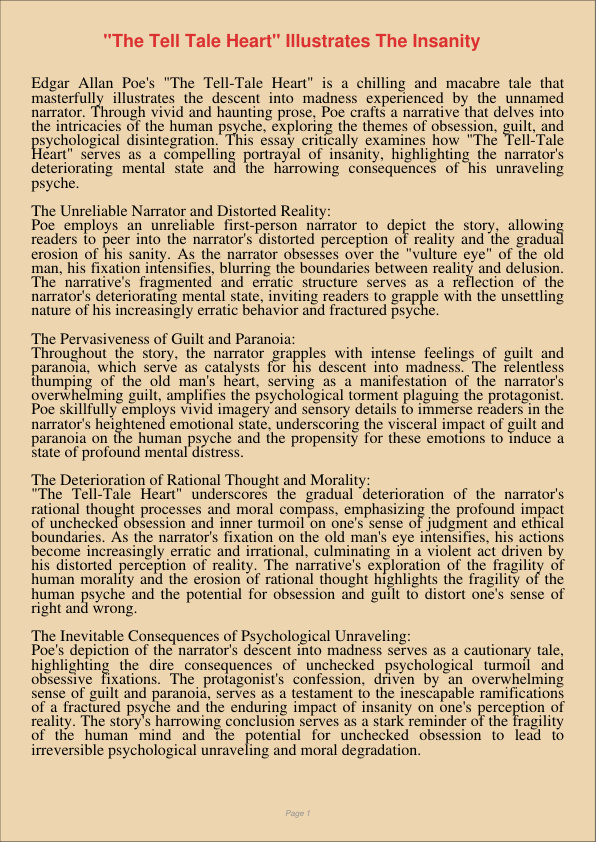The Tell Tale Heart Illustrates The Insanity
Jan 9, 2024
tell tale heart
insanity
English
Health Sciences & Medicine

Edgar Allan Poe’s “The Tell-Tale Heart” is a chilling and macabre tale that masterfully illustrates the descent into madness experienced by the unnamed narrator. Through vivid and haunting prose, Poe crafts a narrative that delves into the intricacies of the human psyche, exploring the themes of obsession, guilt, and psychological disintegration. This essay critically examines how “The Tell-Tale Heart” serves as a compelling portrayal of insanity, highlighting the narrator’s deteriorating mental state and the harrowing consequences of his unraveling psyche.
The Unreliable Narrator and Distorted Reality: Poe employs an unreliable first-person narrator to depict the story, allowing readers to peer into the narrator’s distorted perception of reality and the gradual erosion of his sanity. As the narrator obsesses over the “vulture eye” of the old man, his fixation intensifies, blurring the boundaries between reality and delusion. The narrative’s fragmented and erratic structure serves as a reflection of the narrator’s deteriorating mental state, inviting readers to grapple with the unsettling nature of his increasingly erratic behavior and fractured psyche.
The Pervasiveness of Guilt and Paranoia: Throughout the story, the narrator grapples with intense feelings of guilt and paranoia, which serve as catalysts for his descent into madness. The relentless thumping of the old man’s heart, serving as a manifestation of the narrator’s overwhelming guilt, amplifies the psychological torment plaguing the protagonist. Poe skillfully employs vivid imagery and sensory details to immerse readers in the narrator’s heightened emotional state, underscoring the visceral impact of guilt and paranoia on the human psyche and the propensity for these emotions to induce a state of profound mental distress.
The Deterioration of Rational Thought and Morality: “The Tell-Tale Heart” underscores the gradual deterioration of the narrator’s rational thought processes and moral compass, emphasizing the profound impact of unchecked obsession and inner turmoil on one’s sense of judgment and ethical boundaries. As the narrator’s fixation on the old man’s eye intensifies, his actions become increasingly erratic and irrational, culminating in a violent act driven by his distorted perception of reality. The narrative’s exploration of the fragility of human morality and the erosion of rational thought highlights the fragility of the human psyche and the potential for obsession and guilt to distort one’s sense of right and wrong.
The Inevitable Consequences of Psychological Unraveling: Poe’s depiction of the narrator’s descent into madness serves as a cautionary tale, highlighting the dire consequences of unchecked psychological turmoil and obsessive fixations. The protagonist’s confession, driven by an overwhelming sense of guilt and paranoia, serves as a testament to the inescapable ramifications of a fractured psyche and the enduring impact of insanity on one’s perception of reality. The story’s harrowing conclusion serves as a stark reminder of the fragility of the human mind and the potential for unchecked obsession to lead to irreversible psychological unraveling and moral degradation.
In conclusion, Edgar Allan Poe’s “The Tell-Tale Heart” serves as a haunting portrayal of insanity, delving into the intricate complexities of the human psyche and the devastating consequences of unchecked obsession and guilt. Through the narrator’s descent into madness, Poe underscores the fragility of the human mind and the potential for psychological turmoil to distort one’s perception of reality and moral judgment. “The Tell-Tale Heart” stands as a timeless exploration of the haunting effects of insanity on the human condition, inviting readers to confront the darker recesses of the human psyche and the enduring legacy of unresolved psychological torment.